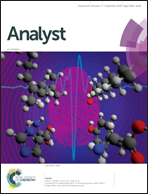An electrochemiluminescence cytosensor for sensitive detection of HeLa cells based on a signal amplification strategy of Au-NaYF4:Yb,Er nanocomposites
Abstract
A novel electrochemiluminescence (ECL) cytosensor was proposed for the quantitative detection of HeLa cells (human cervical cancer cells) with the help of a signal amplification strategy. Firstly, the Au-NaYF4:Yb,Er nanocomposites were prepared by a simple in situ hydrothermal method and characterized by transmission electron microscopy (TEM) images, X-ray diffraction (XRD) patterns, UV-vis spectra and Fourier transform infrared (FTIR) spectra. Compared with the bare NaYF4:Yb,Er nanocomposites, the ECL intensity of Au-NaYF4:Yb,Er nanocomposites was greatly enhanced by about 4.2-fold which can be attributed to the good conductivity of gold nanoparticles (Au NPs). The nanocomposites showed high and stable ECL emission, fast response and superior conductivity, all of which were advantageous to the ECL detection. Furthermore, HeLa cells were immobilized on the modified electrode via the interaction between folic acid and a folate receptor present on the cell surface. The ECL cytosensor showed satisfactory sensitive response to HeLa cells in a linear range of 4.25 × 102–4.25 × 105 cells per mL with a low detection limit of 326 cells per mL. The proposed cytosensor had good sensitivity and stability, which can offer a great potential platform for bioassay analysis.



 Please wait while we load your content...
Please wait while we load your content...